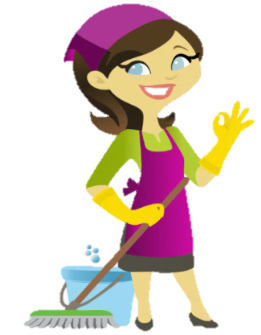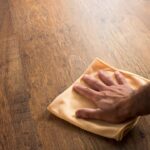Choose a soft-bristled broom angled. Take preemptive action to get into corners and wide enough to swiftly do the job—moving with the grain, of course.
Attack sticky debris ASAP with a damp clean cloth, a mini squirt of wood floor cleaner, and a vigorous rub; if you don’t like to crouch, plant one foot on a rag. Lift off dust and pet hair with a microfiber mop head, ideally treated with a positive electric charge so it can capture negative-ion ephemera. Keep the mop head moving, again with the grain.
5 Ways to Avoid Major Damage
- Don’t ignoring wet or sticky spills. They won’t go away on their own. Did an ice cube just shoot under the table? Go get it.
- Don’t bring on the heavy equipment. You can damage the finish by attacking with a broom meant for the garage or a floor-cleaning machine designed for tougher flooring.
- Avoid applying the wrong cleaning product. Experts say Murphy Oil Soap can leave a residue on polyurethane. Paste wax simply makes it slippery. As for acrylic polishes that claim to remove the glow while putting more on? They can dull polyurethane—just remove the grime and it will shine.
- Be aware of flooding the zone. Standing water and overly wet mops shoot moisture between boards and through tiny tears in the finish that form when wood shrinks and expands with the weather. Over time, moisture can damage the wood.
- No steam cleaning. Never on wood. Save it for tile, linoleum, and vinyl.
What To Use To Clean Hardwood Floors
For a neutral solution, you want a pH level of about 7, or matched to cured poly; higher is too alkaline, and lower is okay for an all-purpose cleaner, but not here
Is it Safe to Use Vinegar to Clean Hardwood Floors?
Don’t use vinegar or baking soda solutions. Old-fashioned remedies involving vinegar or dish detergent can’t do the same job as today’s multi-functioning solutions and can actually damage or dull polyurethane.
Solvents: Speed the drying process, reducing exposure to moisture and making the job go faster; they also minimize streaking and filmy buildup.
- Surfactants: Loosen grease and dirt and emulsify them so they can move to the mop head;
- Chelators: Found in Method’s cleaner, fight water spotting and snow-melt salts.
- Citric Acid: Breaks up dirt and combines with alkaline ingredients to help achieve a neutral pH.
- Oxidizers: Release hydrogen peroxide to bust up dirt on long-neglected floors and are in extra-strength solutions

